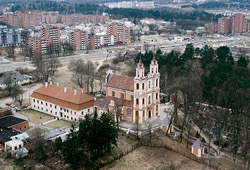History
This Way of the Cross was built in thanksgiving to God for Lithuania’s victory over the Russian army in a war that lasted from 1655-1661. The wooded hills of the Verkiai district, with names like Golgotha, Zion, Mary’s Hill and the Mount of Olives, and a stream similar to the one in Jerusalem’s Cedron Valley, offered an ideal setting for the new “Calvary”. The first wooden church and wayside chapels were in place by 1669. There is evidence that the bishop of Vilnius led a procession to the site a few years earlier even, on April 11, 1664, which was Good Friday.
Care of the Calvary and its pilgrims was entrusted in 1668 to local Dominicans from the Convent of the Holy Spirit in Vilnius. In 1675, the task was transferred to Observant Dominicans from the Congregation of St Louis Bertrand, who had come from Warsaw. That same year the entire complex burned down, forcing the new caretakers to begin reconstruction work. The first brick Church of the Invention of the Holy Cross was built in 1700.
In 1701, the parish of Verkiai was established under the patronage of St Hyacinth, a popular Dominican saint. In 1720, a statue of Christ carrying the Cross was blessed. It had been erected 10 years before during an outbreak of the plague in a chapel in Šnipiškės, in the place where pilgrims used to gather for journeys to Jerusalem. The statue of Jesus, which pilgrims passed on their way to Vilnius Calvary, soon gained the fame of being miraculous and became quite popular. In 1755, the Calvary was returned to its previous proprietors, the Dominicans of Vilnius, who launched the construction of an impressive new church, a monastery and 20 new brick chapels. The main sponsors of the effort were minor nobility from the Grand Duchy of Lithuania, with support from the bishop of Vilnius and other clergy. The Church of the Invention of the Holy Cross and the 20 chapels were blessed in 1772.
The architecture of the Calvary ensemble thereafter changed little until the middle of the 20th century. The only significant damage was inflicted by the French army, which in 1812 occupied the church and monastery, turning them into a barracks and a hospital. After the Napoleonic wars, all the chapels were refurbished. Tsarist authorities confiscated part of the land of the monastery in 1842, and in 1850 closed the monastery itself. The Dominican friars were evicted and sent to the monastery of Trakai, while the church was left to the custody of diocesan clergy.
But popular habits of visiting Vilnius Calvary were not disrupted by the monastery‘s closure. On the contrary, such visits became even more popular in the late 19th and early 20th centuries, and the 18th century complex, with its church, monastery and 35 stations of the Cross, remained little changed. Change came with the Soviet government, which tried in all sorts of ways to suppress pious traditions like visits to holy places. During 1962 and 1963, the chapel-stations at Vilnius Calvary were demolished one by one. In fact, all but the four chapels nearest the church were dynamited during a single night in 1962. Demolition was completed in 1963. Also destroyed was the chapel beyond the Green Bridge with its statue of Christ bearing the Cross, which for so long had shown pilgrims the way from Vilnius to Calvary.
After Lithuania regained independence in 1990, work to rebuild the chapels was begun. Thanks to the efforts of pastors Julius Baltušis, Raimundas Varaneckas and Kęstutis Latoža, as well as the offerings made by many benefactors, the chapels were completely rebuilt and solemnly blessed at Pentecost in 2002.








